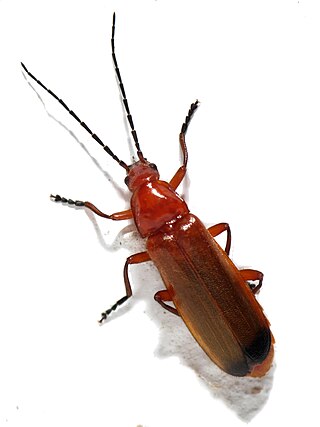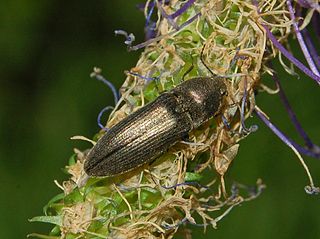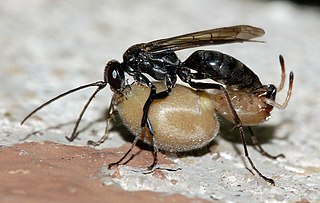
Giovanni Antonio Scopoli was an Italian physician and naturalist. His biographer Otto Guglia named him the "first anational European" and the "Linnaeus of the Austrian Empire".

Rhagonycha fulva, the common red soldier beetle, also misleadingly known as the bloodsucker beetle, and popularly known in England as the hogweed bonking beetle is a species of soldier beetle (Cantharidae).

Micropterix aruncella is a species of moth belonging to the family Micropterigidae, which is distributed throughout Europe. The imago was first described by Giovanni Antonio Scopoli in 1763. This species is one of the best known members of the family, being found in a wide range of habitats from sea level to over 2,000 metres (6,600 ft); the only habitat not favoured by this species is dense woodland.

Phyllobius glaucus is a species of weevil found across Europe, especially in carrs. It is a pest of a variety of fruit trees, but has little economic effect. It was first described by Giovanni Antonio Scopoli in 1763.

Tetragnatha extensa is a species of spider found across the Northern Hemisphere. It has an elongate body, up to 11 mm (0.43 in) long, and adopts a straight line posture when alarmed. It lives on low vegetation in damp areas, and feeds on flying insects which it catches in its web.

Spilostethus pandurus is a species of "seed bugs" belonging to the family Lygaeidae, subfamily Lygaeinae.

Cidnopus pilosus is a species of click beetle belonging to the subfamily Dendrometrinae of the family Elateridae.

The hairy-footed flower bee is a species of bee belonging to the family Apidae.

Chloromyia formosa is a species of soldier flies belonging to the family Stratiomyidae. Another name for it is Broad centurion.

Agalenatea redii is a species of 'orbweavers' belonging to the family Araneidae subfamily Araneinae.

Melanotus villosus is a species of beetle in the family Elateridae and the genus Melanotus.

Auplopus carbonarius is a spider wasp of the family Pompilidae. Uniquely among the British group it constructs a nest of barrel-shaped cells in which spiders are stored and the larvae develop. The British common name is sometimes given as the potter spider wasp or the yellow-faced spider wasp.

Anastrangalia dubia is a species of beetle of family Cerambycidae.

Scelophysa trimeni, commonly known as the blue monkey beetle, is a species of scarab beetles in the tribe Hopliini, subfamily Melolonthinae.

Enicopus is a genus of soft-winged flower beetles belonging to the family Melyridae, subfamily Dasytinae. Species in this genus are present in most of Europe and in the eastern Palearctic realm.

Anthophora dispar is a species of bee belonging to the family Apidae subfamily Apinae tribus Anthophorini.

Neoitamus cyanurus, the common awl robberfly, is a species of 'robber fly' belonging to the family Asilidae.

Tenthredo crassa is a sawfly species belonging to the family Tenthredinidae.

Coptocephala unifasciata is a species of leaf beetle belonging to the family Chrysomelidae, subfamily Cryptocephalinae.

Libelloides macaronius is a day-flying owlfly species of Europe and Asia. The genus belongs to the family Ascalaphidae, subfamily Ascalaphinae.





















